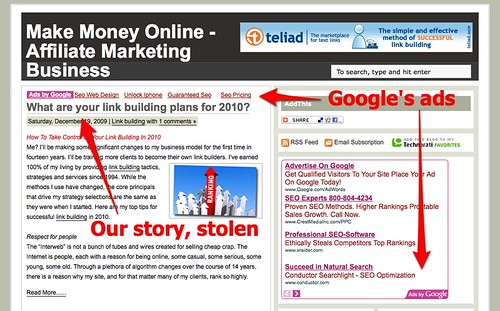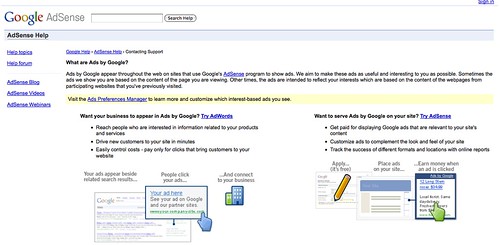Case Study: How Google Hosts & Funds A Copyright-Infringing Web Site
Color me tired. I got a report of a site that reprinted one of our articles without permission. Checking it out, I discovered that miserable combination of someone making money off content they don’t own, paying nothing to host that stolen content on Google’s Blogger service and earning off that content through Google’s AdSense ads. […]
Color me tired. I got a report of a site that reprinted one of our articles without permission. Checking it out, I discovered that miserable combination of someone making money off content they don’t own, paying nothing to host that stolen content on Google’s Blogger service and earning off that content through Google’s AdSense ads. And reporting the infringement is oh so easy. Not.
So here’s the fun loving site:
The most current article shown comes from Search Engine Land. It’s reprinted in its entirety, without permission. There’s even a credit line shoved in at the end:
Newsflash, to anyone who doesn’t get it. You can’t just shove a credit at the end of a story and assume that gives you permission to reprint an entire article. You have to ask the source. No ask; no permission.
Sometimes this happens by accident. People just don’t know any better. Usually when it comes to my attention, I track down a contact address or form, send a short, polite note that summarizing an article and linking to it is fine, but reprinting it is not. Usually, that works just fine.
In this case, there is no contact address. That’s got me all ranty. Hey Google — you’re going to let someone have free web space? Make it required that there’s a contact address of some type. This blog doesn’t have the standard navbar that has the report abuse link right at the top of the page, probably because they use FTP publishing. Well, figure out a way to require that of anyone. It’s absurd people have to otherwise hunt down a way to report this junk you allow to be hosted.
I did track down links to use. One is the DMCA form. I can see that two pages were stolen from our site. So, I could fill in the incredibly long and complicated form and enjoy the fun of Whack-A-Mole.
But you know, I shouldn’t have to do this. I should have a much simpler form that I can fill out that says “Hey Google, look at this site you’re hosting for free. They’ve clearly stolen our articles — you can see they’ve stolen some other ones. Why don’t you suspend them and see if they mount a defense. If so, then drag out the complicated forms. Otherwise, employ some common sense.”
Yeah, that’s the damn form I want. But you don’t have it. You do have a report spam blog form, so I used that. Just put in the URL and whoops! That’s all you do. That’s all you ask for. You don’t ask for any comments about the blog, what’s wrong with it and so on. Apparently, the URL alone is enough for you to then respond with this not-so-reassuring confirmation message:
Thanks for reporting this possible Terms of Service violation. We will examine it soon and take action as necessary.
Yeah, I’m believing that. Well, maybe I can hit the blog where it hurts — in the AdSense all over the page. Surely Google AdSense doesn’t want to make money off infringing c0ntent, right? Surely there should be an easy way for someone who sees Google ads all around stolen material to report this. Right?
Sure. Those “Ads By Google” links are a way to do it. But check it out. When I clicked on that link, here’s what I saw:
It’s an ad for AdSense and AdWords.
It wasn’t until I went back and looked harder, scrolled down, that I discovered this:
Oh, there’s the link to report a problem with the ads. How could I have missed it?
Hey, that new Browser Size tool you just rolled out? I ran it against that Ads By Google landing page. It tells me, using your own stats, that 80% of the people coming to that page will have to scroll to see that link.
Now here’s a thought. I think most people on the web who want to run online ads at this point know you have them. That “Ads By Google” link? It really doesn’t need to be a product pitch for people who click on it. No, you’ve instead got two key audiences. Those who want to opt-out of your behavioral targeted “interest” ads and those who want to report some crappy site that you’re helping fund. So let’s fix that page and make the message be focused as it should be.
Let me add that when you finally do locate the policy violation page, it rocks. You’re giving me exactly what I wish Blogger would — that one click “Hey, there’s something screwy with this site” option:
Thanks. Fingers crossed, you’ll act on it.
Contributing authors are invited to create content for Search Engine Land and are chosen for their expertise and contribution to the search community. Our contributors work under the oversight of the editorial staff and contributions are checked for quality and relevance to our readers. Search Engine Land is owned by Semrush. Contributor was not asked to make any direct or indirect mentions of Semrush. The opinions they express are their own.







